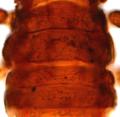Stephanothrips bradleyi
Recognition data
Distinguishing features
Both sexes wingless. Body and legs brown, tube paler, antennal segments I–II yellow, III shading to brown at apex. Head longer than wide, cheeks straight, anterior margin with four large pale setae arising from prominent tubercles; dorsal surface with many small setae on tubercles, postocular setae not distinguished; compound eyes small, reduced to about five ommatidia; maxillary stylets retracted to eyes, close together medially. Antennae short, 5-segmented; segment III large (due to fusion of three morphological segments), V constricted at base. Pronotum with one pair of prominent setae, at posterior angles. Fore tarsi with no tooth. Meso and metanotum transverse with small setae on tubercles. Abdominal tergite IX longer than wide; tube longer than head, with long anal setae.
Male similar to female but smaller.
Related and similar species
The genus Stephanothrips includes 29 described species, mainly from Southeast Asia, but with three from eastern USA, one from Texas and S. bradleyi from California.
Taxonomic data
Current valid name
Stephanothrips bradleyi Hood
Original name and synonyms
- Stephanothrips bradleyi Hood, 1927: 204
Family placement
Phlaeothripidae, Phlaeothripinae
Biological data
Life history
Breeding on dead branches, or possibly in leaf litter.
Host plants
Unidentified fungal hyphae on dead branches and dead leaves.
Tospoviruses vectored
None
Crop damage
None
Distribution data
Area of origin
Western USA
Distribution
California




